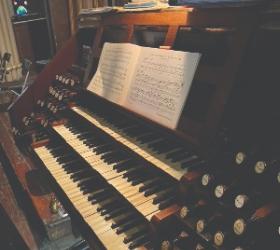
Hupalo & Repasky Pipe Organs, LLC, San Leandro, California
Zion Lutheran Church,
Piedmont, California
Church history
The Zion Lutheran congregation established itself in Oakland in 1882 and by 1886 had purchased their first house of worship. From the beginning, education and music have been important elements of the church’s mission. To this day, the church provides Christian education for kindergarten through the eighth grade, with music being a large part of the educational program at Zion Lutheran School.
During the 1920s, the congregation renewed their Victorian facilities in Oakland with a new parsonage, parish hall, school, and worship facility. It is here, in the church’s second worship facility, that in 1930 M. P. Möller built their opus 5769. This two-manual organ contained thirty-one registers.
In 2007, Piedmont was named “Best Place to Live” in the United States by Forbes. It was in this residential area surrounded by Oakland that the congregation of Zion Lutheran Church dedicated their most recent site on April 4, 1954. The current church complex is situated atop a high bluff, with a background of stone hills with pockets of dense shrubs and trees. Attached to the Mediterranean-style church is a bell tower, offices, school classrooms, meeting rooms, kitchen, barbeque area, library, and gymnasium. The church edifice is designed to accommodate 350 persons.
The church’s 1930 Möller pipe organ
Möller’s opus 5769 was brought from the parish’s second church in Oakland, relocated to their present site, and placed in two chambers with separate expression in the rear balcony behind the terraced choir seating area. As there was no façade, the choir “enjoyed” watching the two sets of vertical shades open and close. From the congregation’s vantage point, the organ looked like two rather large jalousie windows caged by wooden framing.
As with many organs of the 1950s and ’60s, Zion’s Möller organ was enlarged with several high-pitched ranks, and some of the original ranks were replaced with neo-Baroque substitutes. With actions and console parts failing, by 2005 plans were underway to provide Zion Lutheran Church with a new and reliable instrument. As part of this plan, many of the ranks of the extant organ were to be incorporated into their new instrument. The 1930 Möller organ with its additions served the parish until it was removed by us in July 2006. With the organ removed, we loaned the church our large seven-rank continuo organ.
Another Möller organ
Also, as part of the plans for Zion’s new organ, the pipework and offset chests were removed from the 1946 Möller organ, opus 7370, at St. Mark’s Lutheran Church in San Francisco. This organ became available because of the retrofitting of the church and plans by the parish to purchase a new Taylor & Boody organ. It was noted that Richard Purvis was the organist at St. Mark’s during the time this three-manual organ of twenty-four ranks was installed. It is with these two instruments (the augmented Möller opus 5769 and opus 7370) that Hupalo & Repasky Pipe Organs rebuilt, rescaled, and revoiced pipework that provided the new organ for Zion Lutheran Church.
Tonal design of the new instrument
Our concerns were to provide the church with a tonally versatile and cohesive musical instrument, which would have a visual presence in the room, and would be reliable and serviceable. Using many ranks from Möller’s opus 5769 and opus 7370, the original conception for Zion’s new pipe organ envisioned a three-manual organ of forty ranks. This organ would have included a Rückpositiv. However, the organ committee decided instead to plan for a large two-manual instrument.
In working with the organist, David Babbitt, it was decided that the new organ would have a Pedal based on a 16′ Principal. The Great would have a 16′ plenum, the Swell an 8′ plenum, and there would be an assortment of unison tone. There would be a wide variety of flute tone (stopped, chimneyed, open, harmonic) represented. Also included in the tonal design was a selection of wide and narrow strings. Mutation ranks would be drawn from the flute and principal families. This two-manual organ would boast five 16′ ranks. Benefiting the Great plenum, a new German-style Trumpet would be built. For the Swell, a harmonic-rich French-style Trumpet would be provided.
Unfortunately, Mr. Babbitt passed away during the planning stages of the organ. This was a great loss not only to Zion, but also to the musical community in the Bay Area. The church soon found an admirable organist/choir director, Dr. David Hunsberger. It was his opinion that the Cornet Composée in the Swell should be a little stronger. Recalling how he enjoyed the sound of the Cornet on the Silbermann-style organ at the University of Michigan, it was decided to change the ranks to the larger scales used by the Fisk company. So, with the help of Stephen Kowalyshyn, we replaced the Swell mutation ranks with pipes based on Mr. Kowalyshyn’s information.
During the installation it was decided that the beautiful Clarinet from opus 7370 was too similar in volume to the Oboe. So, a full-throated Cromorne replaced the Clarinet. John Hupalo also decided to use French “tear drop” shallots in the new Cromorne. The generous inclusion of four reed voices in the Swell division of this moderate-sized two-manual organ provides both variety in color and a progression in volume.
Physical layout
The previous organ at Zion was installed in two non-communicating chambers. With the removal of opus 5769, the in-between area was opened up to allow placement for the Pedal ranks and to allow pitch transfer from one division to the other during tuning. This was virtually impossible on the previous organ. To aid tonal projection, the chambers were lined with two layers of 5/8″ sheetrock and then painted. The Swell chamber was placed in the left, the unenclosed Great in the right chamber, and the Pedal ranks placed in the center area.
Temperament
Another suggestion of Dr. Hunsberger was that the organ should be tuned in a well temperament. The Thomas Young temperament was chosen for its purer major thirds and playability in all keys. Like a good choral ensemble, this tuning helps the organ lock pitch in the more common keys.
Pipework
It was evident from the first that much of the Möller pipework was of excellent quality, especially the pre-World War II zinc pipes. The wooden pipes were cleaned and refinished. The stopped pipes were releathered. The Great 8′, 4′, 22⁄3′, and 2′ plenum ranks were rescaled as appropriate to the tonal scheme of the organ. The Great principals also received new languids. The removal of the old languids had the advantage of lowering the cut-ups, allowing us to revoice the Great plenum. This turned the old Möller diapasons into clear-toned principals. To provide a tonal contrast to the Great principals, the Swell diapasons are voiced and scaled towards a more neo-Romantic sound. The neo-Baroque 8′ Principal from opus 5769 was rescaled and made into the Great 8′ Gamba. Length and slotting were added to these pipes patterned after the Gambas of Cavaillé-Coll. Besides the two manual trumpets, Cromorne, and the Swell Nazard and Tierce, the other newly made stops for this organ include the Great Harmonic Flute and the Swell mixture.
Chests
Both the new Great and Swell main chests are slider chests with magnet pull-downs. It is our philosophy that these traditional-style chests provide a noticeable ensemble for the pipework. Even Ernest Skinner later in his life recognized the benefits of slider chests, with each note sharing a common channel of wind.
Many of the electro-pneumatic bass offset chests from opus 7370 were releathered and incorporated into the new organ. Given the large size of the pallets, they provide a lightning-fast response for the lower notes of the organ.
Façade
To match the architectural style of the church, it was decided to fashion the façade in the American Craftsman style. The center five-pipe flat is flanked on both sides by three flats of five pipes each. The styles, rails, toe boards, and corbels are of quarter-sawn white oak proportioned in the Craftsman manner. The styles are punctuated with medallions. The molding is highlighted by areas of crimson red.
Starting with low F-sharp of the Pedal 16′ Principal, the façade incorporates the lowest pipes of the Pedal 16′ and Great 8′ Principal. To provide visual uniformity, these zinc pipes were mottled in a terra cotta color, with the upper and lower lips in painted verdigris.
Console and control system
The console is our standard terraced-style, roll-top design, with three rows of drawknobs on either side of the keyboards. The shell is made of quarter-sawn white oak, with French polished European pearwood used in the stop jamb and nameboard area. The drawknobs are of ebony, as are the sharps. The manual key covers are of bone. The console is placed in a fixed central position in the choir loft to provide the organist with space for conducting both choir and instrumentalists.
A computerized system controls the combination action, memory, and the complex switching system of the organ. It provides the organist with a transposer, 99 levels of memory, a piston sequencer, and MIDI In and Out, as well as many programmable features.
Personnel
The following craftsmen assisted in the construction of our opus 3: Mark Dahlberg (technical designer), Robin Fox, John Haskey, Robert Hoffmann, John Hupalo, Bruno Largarce, Gerard Montana, Steve Repasky, Bob Schertle, Lawrence Strohm, William Visscher, Shayne Ward, and David H. Zechman.
Organ dedication
The organ was dedicated to a full house in a solo recital on Sunday afternoon, January 25, 2009 by Stanford University Organist Robert Huw Morgan.
Dedication program:
Dialogue, L. Marchand
Fantasia in f, K. 608, W. A. Mozart
Homage to Handel, S. Karg-Elert
Prelude in E-flat, S. 552, J. S. Bach
An Wasserflüssen Babylon, S. 653, Bach
Sonata V in C, S. 529, Bach
Fugue in E-flat, S. 552, Bach
—Steve Repasky
Hupalo & Repasky Pipe Organs, LLC, 2008, 35 stops, 33 ranks
GREAT
16′ Hohl Flute 61 pipes
8′ Principal 61 pipes
8′ Harmonic Flute 49 pipes
8′ Gamba 61 pipes
4′ Octave 61 pipes
4′ Röhr Flute 61 pipes
22⁄3′ Twelfth 61 pipes
2′ Fifteenth 61 pipes
13⁄5′ Seventeenth 61 pipes
Mixture IV 244 pipes
8′ Trumpet 61 pipes
Chimes 25 tubes
SWELL
8′ Diapason 61 pipes
8′ Stopt Diapason 61 pipes
8′ Salicional 61 pipes
8′ Celeste 61 pipes
4′ Principal 61 pipes
4′ Flute 61 pipes
22⁄3′ Nazard 61 pipes
2′ Piccolo 61 pipes
13⁄5′ Tierce 61 pipes
Plein Jeu III 183 pipes
16′ Fagot 61 pipes
8′ Trompette 61 pipes
8′ Oboe 61 pipes
8′ Cromorne 61 pipes
Tremolo
PEDAL
16′ Principal 32 pipes
16′ Bourdon 32 pipes
8′ Octave 12 pipes
8′ Bourdon 12 pipes
4′ Choral Bass 12 pipes
4′ Bourdon 12 pipes
16′ Posaune 32 pipes
16′ Fagot Swell
8′ Trumpet 12 pipes
4′ Schalmei Fagot
Couplers
Unison, sub, and super couplers provided on tilting tablets
Accessories
6 general thumb pistons and toe studs
5 divisional thumb pistons for each of the three divisions
Setter and general cancel thumb pistons
Up and down thumb pistons
3 reversible thumb and toe pistons for unison couplers
Reversible thumb and toe pistons for full organ
Crescendo pedal
Zimbelstern: 8 bells
Tuning
Thomas Young
Photo credit: John Hupalo
Hupalo & Repasky Pipe Organs
510/483-6905
www.hupalorepasky.com




